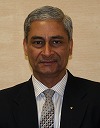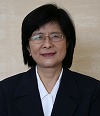
Subhash Bhalla
Professor

Yutaka Watanobe
Assistant Professor

Wanming Chu
Assistant Lecturer

Junya Terazono
Assistant Lecturer

Subhash Bhalla Professor |

Yutaka Watanobe Assistant Professor |

Wanming Chu Assistant Lecturer |

Junya Terazono Assistant Lecturer |
Information systems in transportation, health-care and public utility services depend on large scale data management systems. Research activity in Database Systems is focused on broadening their range of applicability. It is also focused on improving the performance of domain specific applications.
Large applications for Services use database systems as a basic part for web data resources. This year the laboratory organized an International workshop with many invited distinguished researchers during 29-31 March. The proceedings have been published for the 6th workshop on "Databases in Networked Information System (DNIS)" by Springer-Verllag in the Lecture Notes in Computer Science series (LNCS) in Volume 5999. The delivered lecture and manuscripts are being utilized to develop the stateof-the-art lectures on current research problems. These created a focused view on new research problems. many current aspects of web related research activity were discussed at the workshop.
In addition to complexity in features such as multiple attributed data, many new types of raw data are emerging that need to be captured by DBMSs for information extraction. Many research efforts are being made to make suitable Object-Relational architectures for spatial databases.
Most of the advances in techniques concentrate on capturing more meaning within data. A number of researchers are actively developing improved data management strategies using Business Intelligence and data. This provides a challenging area for study. The domains of activity include :
developing new user interfaces and query languages for skilled and semi-skilled users in health-care;
developing infrastructures for computing facilities for cloud computing;
supporting mobile computing applications, and
designing new data models and asynchronous computation models for transaction and services.
The Database Systems Laboratory has research activity concentrating on data modeling as well as transaction processing activity.
Information Processing Systems of future will be a combination of integrated components. There will be components for intelligent problem solving, or decision making, components for specialized data processing and components for shared information management. The applications will utilize a shared base of information. Some examples are - business automation, industrial automation, computer-aided design and manufacture, and cartography.
Traditional approaches to transaction management introduce elements of unpredictable delays during transaction processing. Thus, making these not suitable for adoption in new application environments. The techniques for time-critical transactions are applicable to Mobile databases and multimedia databases.
The goal of this research is to study the feasibility to endow a computational system with the ability to process information. As an experimental platform the laboratory is building a web retrieval system that enables users to retrieve multimedia information carrying a given subjective (Kansei) content. Such system will prove useful in various areas of information technology such as online shopping, advertising industry, entertainment, design, wearable computers. The modeling issues are reformulated from the complementary points of view:
a multimedia data mining approach to address the mapping between impression (or Kansei) words and multimedia impressions,
An approach that involves the user in the modeling process.
Query Language with reference to user skills
Prototype systems to access dynamic contents through web based information systems are in progress. These emulate mobile e-commerce activity in banking and Geographic Information Systems, for test and studies. The test protypes have been evolved based on research on new easy-to-use search and also new query language interfaces.
T. Kuroiwa and S. Bhalla. Book recommendation system for utilisation of library services. International Journal of Computational Science and Engineering, 5(3):207-213, 2010.
In addition to using the many conventional approaches for making recommendation systems, this paper proposes a complementary recommendation methodology. It is focused on book recommendation. It proposes to make a comprehensive data repository of existing books, available at the level of the user (in a library or a personal bookshelf). Further, by retrieving web reviews of available books and new books by using existing web services, an infrastructure has been developed for need-based book recommendation system. Implementation results show that our book recommendation allows a user to eliminate irrelevant books and presents the desired books to the user from given book set
S. Sachdeva, S. Mchome, and S. Bhalla. Web services security issues in healthcare applications. In 9th IEEE/ACIS International Conference on Computer and Information Sciences, pages 91 96, August 2010.
Many research efforts are in progress for developing unified standards for Electronic Health Records. Such records can be shared for provisions of health care and research. Significant benefits can be realized when the proposed systems are used widely. Additional security requirements are crucial for their wide adoption. Patients want privacy and confidentiality. These systems will be deployed in distributed databases that are available to users through web services. This study examines security challenges in unified health care applications.
S. Mchome, S. Sachdeva, and S. Bhalla. A brief Survey: Usability in Healthcare. In 2010 International Conference on Electronics and Information Engineering (ICEIE), pages V1-463 V1-467, August 2010.
Improvements in usability are essential for the health care industry. Preventing errors, improving efficiency, and making the systems easier to learn is a tall order for this domain. These systems fail because of loss of productivity and steep learning curves. The study presents a brief survey of usability. It examines the importance of usability according to some of the recent trends in domain. It provides an analysis according to various parameters among those trends.
S. Rajam, R. Cortez, A. Vazhenin, and S. Bhalla. Design Patterns in Enterprise Application Integration for e-Learning Arena. In 13th International Conference on Humans and Computers (HC2010), pages 81 88, December 2010.
Pattern based design is an effective way to avoid an expensive process of reinventing, rediscovering and revalidating agnostic software artifacts. The Enterprise Application Integration (EAI) leverages the reusability factor of an application by applying decoupling and location transparency in the communication of the disparate applications and services. Design patterns are reusable solutions to solve recurring issues pertaining to the Functional, Non-Functional and Implementation tasks.
S. Rajam, R. Cortez, A. Vazhenin, and S. Bhalla. E-Learning Computational Cloud (eLC2): Web Services Platform to Enhance Task Collaboration. In 2010 IEEE/WIC/ACM International Joint Conference on Web Intelligence and Intelligent Agent Technology, pages 350-355, August 2010.
A significant proportion of e-Learning services are delivered through Cloud Computing. These use Web services as an interface integrator to support communication across heterogeneous platforms over internet protocols. Similarly, a high level of task collaboration is needed to form an e-Learning community. Therefore, we propose an e-Learning Computational Cloud (eLC2) based on the Model-ViewController design patterns paradigm.
S. Rajam, R. Cortez, A. Vazhenin, and S. Bhalla. Enterprise Service Bus Dependency Injection on MVC Design Patterns. In IEEE TENCON2010 International Technical Conference, pages 1015 1020, November 2010.
Paper deals with the design issues of an e-Learning Computational System based on a Task Management Model. One of the main components of the proposed eLearning Computational Cloud is the Controller acting as an Enterprise Service Bus (ESB) for absolute Model abstraction from outside references. Simultaneously, View is completely decoupled from Model and ultimate privacy and security is achieved for the business data objects.
S. Rajam, R. Cortez, A. Vazhenin, and S. Bhalla. E-Learning Distributed Cloud Built on MVC Design Patterns for Service Task Management. In Euro-American Conference on Telematics and Information Systems, EATIS-2010, September 2010.
Cloud computing is prevalently influencing the present day business trends and operations. Due to Cloud's enticing features, that can be measured by the ease in which the services are delivered to a range of consumer demands without changing the underlying technological implementations or the economics associated with the systems. The e-Learning arena is also not an exception to distance itself away from Cloud driven computing technology. The key point in the e-Learning environment is to process any type of diverse problem within a moderate response time across ubiquitous network channel and securely deliver the output to the authorized user on the most user-friendly interface.
M. Sifer, J. Lin, Y. Watanobe, and S. Bhalla. Integrating keyword search with multiple dimension tree views over a summary corpus data cube. In Divyakant Agrawal, editor, SIGMOD 2010, pages 1167-1170, New York, June 2010. ACM, ACM Publications.
We demonstrate a system that integrates a novel OLAP component with a keyword search engine, to support querying over sparse and ragged corpus data. The key contribution of our system is the integration of dynamically selected point sets such as search results with OLAP querying over aggregated data. During the demonstration, participants will be able to enter a keyword search; observe the returned list of result files; observe distributional features such as outliers and clusters of results in the corpus in multiple dimension views; and select and partition corpus slices in the OLAP component to narrow search results.
S. Suzuki, C. Honda, H. Naru, T. Morota, N. Asada, H. Demura, Y. Ogawa, K. Kitazato, and J. Terazono. Preliminary Result of Optical Maturity of Small Rayed Lunar Craters. In Proc. of 10th COSPAR General Assembly, pages 0-0. COSPAR, July 2010.
This research is based on Kaguya data, Japanese lunar explorer, and reveals optical maturity of small craters with rays (fresh craters) based on crater chronology.
J. Terazono, R. Nakamura, S. Kodama, N. Yamamoto, H. Demura, N. Hirata, Y. Ogawa, J. Haruyama, M. Ohtake, and T. Matsunaga. WISECAPS: Web-based Interactive Secure Environment for Collaborative Analysis of Planetary Science. In Database Systems for Advanced Applications: 15th International Conference, DASFAA 2010, International Workshops: GDM, BenchmarX, MCIS, SNSMW, DIEW, UDM, LNCS (Lecture Note in Computer Science) 6193, pages 58-68. DASFAA 2010, Springer-Verlag, April 2010.
We developed Web-GIS based lunar and planetary exploration data analysis environment, called WISE-CAPS (Web-based Integrated Secure Environment for Collaborative Analysis of Planetary Science). This presentation reports current implementation and its highlights, including user control mechanism and layering function.
J. Terazono, H. Fukuhara, I. Koseda, R. Fujita, T. Miyazaki, S. Saito, and T. Hayashi. Service Oriented Architecture Realized by a Messaging Network. In Proc. of 2010 IEEE/IFIP Network Operations and Management Symposium, pages 0-0. IEEE/NOMS 2010, April 2010.
Messaging Network is a new concept of overlay network over the existing IP-based network. This presentation introduces some notable point of the Messaging Network and shows some examples based on this concept.
Yamin Li, Shietung Peng, and Wanming Chu. Parallel Prefix Computation in the Recursive Dual-Net. In Jong Hyuk Park Sang-Soo Yeo Ching-Hsien Hsu, Laurence Tianruo Yang, editor, Algorithms and Architectures for Parallel Processing: 10th International Conference, ICA3PP 2010, pages 54-64, Busan, Korea, May 2010. IEEE, Springer-Verlag.
In this paper, we proposed an efficient algorithm for parallel prefix computation in recursive dual-net, a newly proposed network. The recursive dual-net RDNk(B) for k < 0 has (2n0)2k=2 nodes and d0 + k links per node, where n0 and d0 are the number of nodes and the node-degree of the base network B, respectively. Assume that each node holds one data item, the communication and computation time complexities of the algorithm for parallel prefix computation in RDNk(B); k < 0; are 2k+1 − 2 + 2k * Tcomm(0) and 2k+1 − 2 + 2k * Tcomp(0), respectively, where Tcomm(0) and Tcomp(0) are the communication and computation time complexities of the algorithm for parallel prefix computation in the base network B, respectively.
Yutaka Watanobe, Nikolay Mirenkov, and Rentaro Yoshioka. Browsing and Editing Tool for Programming in Pictures. In H. Fujita and J. Sasaki, editors, Selected Topics in Applied Computer Science, pages 242 250. WSEAS Press, 2010.
A tool that enables programming in pictures based on Filmification of Methods (FIM) is presented. FIM is an approach where pictures and moving pictures are used to specify and program computational algorithms. The key contribution of the tool is the integration of sub-systems for organizing a visual programming environment in which end-users can easily access, through web browsers, special libraries of software components and "algorithmic characters" and create their own components. Using the tool, the users are able to retrieve library components, browse and edit them, generate executable codes, execute them to observe computational results, and upload and share the components. To facilitate the processes of understanding and manipulations with components, the tool is based on a few visual languages and appropriate interfaces. In addition, the tool allows to export the programs in pictures in several formats, including Adobe Flash animations, PNG or JPEG images to create, for example, educational materials. The scalability of the library of algorithmic characters and the library of software components are also discussed.
Yutaka Watanobe, Rentaro Yoshioka, and Nikolay Mirenkov. Embedded Clarity in Filmification of Methods. In Hamido Fujita, editor, New Trends in Software Methodologies, Tools and Techniques, volume 217, pages 70-82. IOS Press, 2010.
A multilevel approach to realize a self-explanatory representation of symbols, variables, language constructs and software components is considered. Some aspects related to the implementation of the approach within the concept of Filmification of methods are provided. In particular, super-symbols and constructs of Language of Integrated view and Language of Algorithmic interFaces of a cyberFilm programming environment are analyzed and examples of embedded-clarity support are presented.
Rentaro Yoshioka, Yutaka Watanobe, and Nikolay Mirenkov. Open set of algorithmic characters. In Selected Topics in Applied Computer Science, pages 327-334, 2010.
Programming in pictures (or filmification of methods) is an approach where pictures and moving pictures are used as (super-) characters to represent algorithms. There are two types of pictures. Compound pictures define algorithmic steps and generic pictures define the contents of compound pictures. In this paper we focus on generic pictures by providing their overview, classification and examples. We also show how the syntax-semantic gap can be bridged by the pictures and how the readability and understandability of picture-based programs are realized. In addition, the scalability of computation represented by the super-characters and the expandability of these character sets are considered.
Kazumi Nemoto and Yutaka Watanobe. An Advanced Search System for Learning Objects. In Humans and Computers, pages 94-99, 2010.
This paper presents an advanced search system which enables end users to search information sotred in an e-learning system. Records in a database deployed in the e-learning system are mapped to the learning objects, which include problems, user, submission records, accepted solutions, contests (exercises), problem setters, and so on. The system employs an idea of query-by-object (QBO) approach where the users do not need special knowledge of conventional SQL query writing. In this paper, a general overview of the e-learning system, the QBO approach for the system and its system architecture are presented. Demonstration of the system and its usability are also discussed.
Rentaro Yoshioka, Yutaka Watanobe, and Nikolay Mirenkov. Research and Development of Self-explanatory Programming Language for Safety Analysis., 2010-2011.
Funded by Japan Nuclear Energy Safety (JNES)
A.P Vazhenin, N.N. Mirenkov, T. Maeda, J. Brine, and Y. Watanobe. Development of Ubiquitous Environment Using WWW for e-Learning and High Performance Computing 2009-2012.
Grant-in-Aid for Scientific Research
Daigo Yaginuma. Graduation Thesis: Query Language Interface for Web-based e-Health Data Resources, School of Computer Science and Engineering, March 2011.
Thesis Adviser: W. Chu
Sho Ohtake. Graduation Thesis: GIS-based Online Discussion System for Google Earth and Twitter API, School of Computer Science and Engineering, March 2011.
Thesis Adviser: N. Hirata
Hiroki Sano. Graduation Thesis: Implementing Web Grading System with MVC Structure Based on Super Agile Struts, School of Computer Science and Engineering, March 2011.
Thesis Adviser: Wanming Chu
Yudai Suzuki. Graduation Thesis: Object-based Tourist Information Retrival using Google Maps API, School of Computer Science and Engineering, March 2011.
Thesis Adviser: Wanming Chu
Kou Taniike. Graduation Thesis: Book Management and Recommendation System using Amazon E-Commerce Service, School of Computer Science and Engineering, March 2011.
Thesis Adviser: Wanming Chu
Daigo Yaginuma. Graduation Thesis: Query Language Interface for Web-based e-Health Data Resources, School of Computer Science and Engineering, March 2011.
Thesis Adviser: Wanming Chu
Yuka Takahashi. Graduation Thesis: Platform-Independent Browsers for Programming in Pictures, School of Computer Science and Engineering, 2011.
Thesis Adviser: Yutaka Watanobe pictures and its system architecture are presented. Demonstration of the
Tomoya Numakura. Graduation Thesis: Towards Error-Free Programming in Algorithmic CyberFilm Language, School of Computer Science and Engineering, 2011.
Thesis Adviser: Yutaka Watanobe consists of an open set of visual symbols and is supported by a set of
Yuya Watanabe. Graduation Thesis: Filmification of Methods : PushRelabel Maximum Flow Algorithms in Algorithmic CyberFilm Language, University of Aizu, 2011.
Thesis Adviser: Yutaka Watanobe
Kazumi Nemoto. Graduation Thesis: An Advanced Search System for Learning Objects, School of Computer Science and Engineering, 2011.
Thesis Adviser: Yutaka Watanobe
Tatsuya Ito. Graduation Thesis: Filmification of Methods: Programming in Pictures for Multi-Agent Simulation, School of Computer Science and Engineering, 2011.
Thesis Adviser: Yutaka Watanobe

2011 THE UNIVERSITY OF AIZU ALL RIGHTS RESERVED